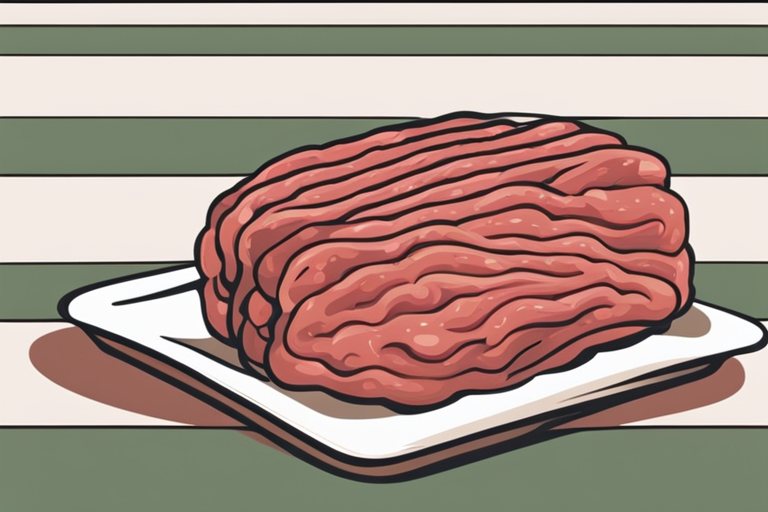
Is Ground Beef Safe to Eat Past the Sell-By Date?
Get Your Free Food Safety Cheat Sheet
30 most common foods with instant answers. Print it and stick it on your fridge—completely free!
Is Ground Beef Safe to Eat Past the Sell-By Date?
When it comes to ground beef, many people are often unsure about its safety once it has passed the sell-by date. In this blog post, we will explore the guidelines for consuming ground beef past its sell-by date and provide you with essential information to make an informed decision. (Ground beef)
Understanding the Sell-By Date
The sell-by date on ground beef packaging is provided by the manufacturer as a guide for retailers to know how long they can display the product for sale. It is not an expiration date, but rather an indication of when the beef is at its peak quality. After the sell-by date has passed, the quality of the ground beef may begin to deteriorate, but it does not necessarily mean that it is unsafe to consume.
Factors to Consider
When deciding whether to eat ground beef past the sell-by date, consider the following factors:
- Storage Conditions: How the ground beef has been stored can significantly impact its safety and quality.
- Appearance and Smell: If the ground beef looks or smells off, it is best to discard it.
- Packaging: Check for any signs of damage or leakage in the packaging.
- Temperature: Ground beef should be stored at a temperature of 40°F or below to prevent the growth of harmful bacteria.
Safety Tips for Consuming Ground Beef
To ensure the safety of consuming ground beef, follow these essential tips:
- Proper Storage: Store ground beef in the coldest part of your refrigerator, preferably on a plate or in a container to prevent any juices from leaking onto other foods.
- Use-By Date: If you are nearing the sell-by date and do not plan to use the ground beef immediately, consider freezing it to extend its shelf life.
- Thawing: Thaw ground beef in the refrigerator, not on the countertop, to prevent bacterial growth.
- Cooking Temperature: Ground beef should be cooked to an internal temperature of 160°F to kill any harmful bacteria.
- Leftovers: If you have cooked ground beef that is past its sell-by date, store it in the refrigerator for no more than 3-4 days.
Signs of Spoiled Ground Beef
Knowing the signs of spoiled ground beef is crucial for food safety. Discard ground beef if you notice any of the following:
- Off Odor: A foul or sour smell indicates spoilage.
- Sliminess: If the ground beef feels slimy to the touch, it is best to throw it away.
- Discoloration: Any unusual color changes, such as gray or greenish hues, are signs of spoilage.
Can You Extend the Shelf Life of Ground Beef?
If you have ground beef that is approaching its sell-by date and you are not ready to use it, you can extend its shelf life by freezing it. Follow these steps for proper freezing:
- Divide: Divide the ground beef into smaller portions for easy thawing and use.
- Wrap: Wrap the portions tightly in plastic wrap or aluminum foil to prevent freezer burn.
- Label: Label the packages with the date of freezing to keep track of how long they have been stored.
By following these steps, you can safely store ground beef in the freezer for up to 3-4 months without compromising its quality.
Conclusion
In conclusion, consuming ground beef past the sell-by date is possible as long as you follow proper storage and cooking practices. Pay attention to signs of spoilage and always prioritize food safety when making decisions about consuming expired foods. When in doubt, it is best to err on the side of caution and discard any ground beef that shows signs of spoilage. By following these guidelines, you can enjoy ground beef safely and deliciously, even after the sell-by date has passed. [Check out our article on ground beef](/food/ground beef) for more information on safe food handling practices. (Ground beef)
Related Posts
Here are some other articles you might find helpful:
- The Importance of Food Safety and Storage
- Is Ground Beef Safe to Eat 4 Days After the Sell-By Date?
- Understanding Food Expiration Dates: A Comprehensive Guide
- How Long Does Refrigerated Beef Last?
- Safely Defrosting Frozen Ground Beef: Tips for Quality and Safety

Authoritative Food Safety References
These agencies and university labs inform every tip and health precaution we publish.
USDA FoodKeeper – Cold Storage Guidelines
Official refrigerator, freezer, and pantry timelines maintained by the U.S. Department of Agriculture.
Visit USDA FoodKeeperFDA Produce Safety Rule & Grower Guidance
Field-to-fridge handling practices that prevent contamination of fruits, vegetables, and leafy greens.
Visit FDA Produce SafetyCDC Foodborne Illness Prevention Hub
Surveillance-backed guidance on pathogens, symptoms, and steps to reduce foodborne illness risk.
Visit CDC Food SafetyUC Davis Postharvest Technology Center
University research detailing optimal storage atmospheres for produce after harvest.
Visit UC Davis PostharvestPenn State Extension – Home Food Preservation & Safety
Peer-reviewed extension bulletins on safe canning, chilling, and reheating practices.
Visit Penn State ExtensionHow long can ground beef be safely stored in the refrigerator?
Is it safe to freeze ground beef past the sell-by date?
What are the signs that ground beef has gone bad?
Can cooking ground beef past the sell-by date make it safe to eat?
Get Your Free Food Safety Cheat Sheet
30 most common foods with instant answers. Print it and stick it on your fridge—completely free! Want more? Upgrade to the complete guide with 70+ foods.
Scan your food directly and get instant safety info using our AI-powered camera feature.